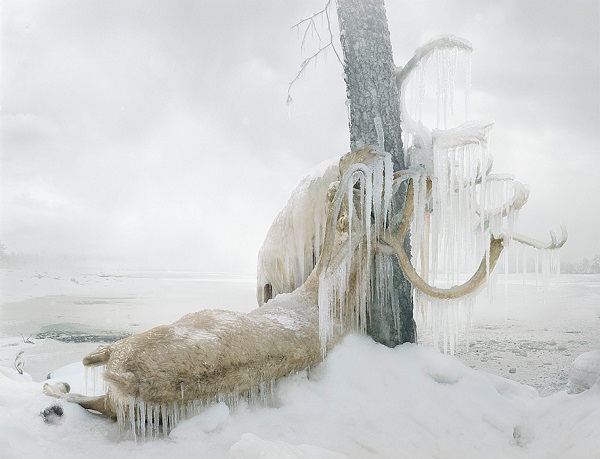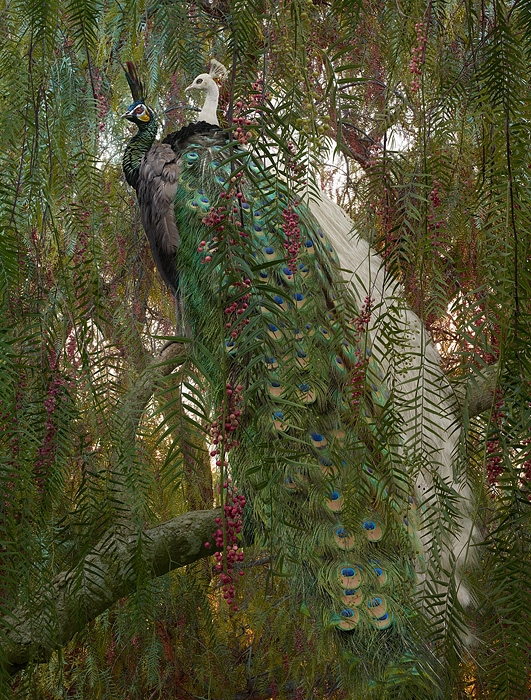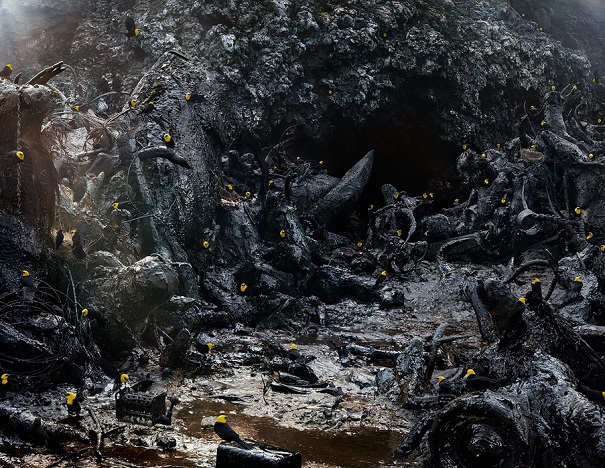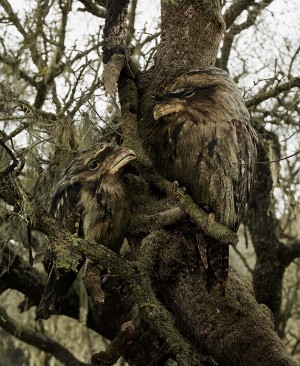Artist of the Week 12/23-12/30: Simen Johan Captures Reality and Fantasy through Animals
In one of Norwegian artist Simen Johan’s most striking photographs, a pair of carrot-colored foxes sits together. Their bodies twist toward each other like those of lovers and their eyes droop down dreamily. These personified animals appear eerie but it’s hard to pin down exactly why. Is it their human-like poses or their beastly nature? In many ways, it’s the interplay of both these characteristics.
Much of Johan’s work focuses on the uncanny. In doing so, he reveals a beautiful, unexamined inner world that appears both unnatural and strangely innocent. In that sense, some things don’t quite add up. This otherworldly quality forces the viewer to question their relationship to the unstable images. But as Johan himself explains, this is precisely what we should not be doing. For him, viewers gain more “if they allow themselves to simply experience [the images].”
In his newest series, Until the Kingdom Comes, Johan presents the viewer with a menagerie of eerily composed animals, placed in backdrops ranging from icy, stark-white forests to hazy, fog-filled meadows.
Like much of his work, the complex, constructed images convey an ethereal mood. Many of the animals in the photographs are concoctions of different species and, at times, even include sculpted parts. The viewer can never trust his or her instincts. Thus, the photographs explore the liminal space between the real and imaginary, beautiful and bizarre, familiar and foreign. As Johan explains, “These dynamic tensions echo the internal conflicts and contradictions inherent to human nature that fuel my work.”
The images consist of animals shot in zoos, nature preserves, museums, and in his studio. He then alters their background, dropping them in previously photographed, and at times, unnatural habitats. Giraffes stand tall in a muddy plane, beheaded by blobs of clouds, while greenish-gray snakes squirm through gnarled trees that mirror their twisted, shadowed forms.
Like the images of the foxes, many of the animals take on human habits. A plucky llama stands proudly, his head held high; two owls crouch on a dark and dewy park bench, as if in conversation. This personification lends to an uncertainty, which causes further tension, a sense of eeriness, and ambiguity in the viewer.
In his artist statement, Johan explains that the title of the series comes not from religious sentiment or natural kingdoms, but the persistent human fantasy that life, somehow, will come to a happy resolution. He sees “living” as an emotion-filled experience, swamped in illusion and desire.
The exhibition follows directly from his past work. In one series, entitled Breeding Ground, he places children, not animals, in constructed settings. Johan captures their play or the remnants of their play, similarly depicting fantasy worlds where primal natures can surge to the forefront and reason can be left behind.
Johan took the time to speak with GALO about Until the Kingdom Comes, tension, and human nature.

“Untitled #159, 2010 (frozen)” by artist Simen Johan. Photo Credit: Simen Johan.
GALO: Can you please describe how ideas for this specific series initially formed in your mind? What is your process from inception to completion? Additionally, how does an individual photograph get formed?
Simen Johan: Ideas come to me, I don’t go get them. I work intuitively. The technical process varies from image to image. There is no formula. The image of the red tree I passed on the highway in Virginia is a straight photograph. The image of the black tar pit I worked on for four years, constructing the set in New Hampshire, then added background elements from Iceland and Peruvian yellow-hooded black birds. The peacocks I photographed in Bali; the tree they’re sitting in I photographed two years later in Spain. Trying to pinpoint or generalize a process is futile. Every image is different.
GALO: Where do you draw inspiration for your work? I know many of the animal subjects are in captivity but in the photographs, they appear to be untouched by human interactions. Do your intended themes rely more heavily on experiences with pets and visits to nature preserves or zoos, or do they come from your own experiences with untouched nature?
SJ: The work has little to do with pets or animals as such, more to do with being. If I draw inspiration from anywhere, it happens unconsciously, or from the things I encounter when I photograph. I photograph intuitively. Once I get started on an image and get a sense of where I want to take it, I might plan to go somewhere to photograph something specific, but because I’m dealing with uncontrollable nature, the image must remain pliable throughout the process.

“Untitled #178, 2012 (Peacock)” by artist Simen Johan. Photo Credit: Simen Johan.
GALO: I know many of these images are stitched together from photographs of various parts of the United States. How do you choose what settings to place the animals in? For example, the image of the bears in farmland is quite anachronistic but beautiful, nonetheless. Is there something about the subject that points you to what setting to place them in?
SJ: The images are from all over the globe, not only the US. I don’t plan. I photograph intuitively, experiment, try different things, and then, eventually, an image that speaks my language and expresses what I’m looking for emerges. Whatever works, works. The bear image I excluded from the series because it doesn’t fit.

“Untitled #171, 2012 (Tarpit)” by artist Simen Johan. Photo Credit: Simen Johan.
GALO: The photographs are very lifelike. The animals seem at home in their environment, as if you set them up there and dictated their positions specifically (almost as if they’re in a school portrait). How much should the viewer be questioning and examining the artificial quality of these photographs and the digitized quality that is, in many ways, opposed to the idea of wilderness, nature, and the animal kingdom?
SJ: I think viewers get more out of the work if they allow themselves to simply experience it. Questioning and examining are matters of the intellect, and the intellect can only comprehend what it already knows.
(Interview continued on next page)

